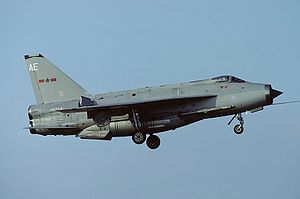The English Electric Lightning is a British fighter aircraft that served as an interceptor during the 1960s, the 1970s, and into the late 1980s. It remains the only UK-designed-and-built fighter capable of Mach 2. The  Lightning was designed, developed, and manufactured by English Electric, which was later absorbed by the newly-formed British Aircraft Corporation. Later the type was marketed as the BAC Lightning. It was operated by the Royal Air Force (RAF), the Kuwait Air Force (KAF), and the Royal Saudi Air Force (RSAF).
Lightning was designed, developed, and manufactured by English Electric, which was later absorbed by the newly-formed British Aircraft Corporation. Later the type was marketed as the BAC Lightning. It was operated by the Royal Air Force (RAF), the Kuwait Air Force (KAF), and the Royal Saudi Air Force (RSAF).
A unique feature of the Lightning’s design is the vertical, staggered configuration of its two Rolls-Royce Avon turbojet engines within the fuselage. The Lightning was initially designed and developed as an interceptor to defend the V bomber airfields[3] from attack by anticipated future nuclear-armed supersonic Soviet bombers such as what emerged as the Tupolev Tu-22, but it was subsequently also required to intercept other bomber aircraft such as the Tupolev Tu-16 and the Tupolev Tu-95.
…on the morning of 4 August 1954, WG760, piloted by Roland Beamont, flew for the first time from Boscombe Down. One week later, WG760 officially achieved supersonic flight for the first time, having exceeded the speed of sound during its third flight. During its first flight, WG760 had unknowingly exceeded Mach 1 (1,225 km/h), but due to position error, the Machmeter only showed a maximum of Mach 0.95 (1,164 km/h). The occurrence was noticed during flight data analysis a few days later. While WG760 had proven the P1 design to be viable, it was limited to Mach 1.51 (1,850 km/h) due to directional stability limits. In May 1956, the P1 received the “Lightning” name, which was said to have been partially selected to reflect the aircraft’s supersonic capabilities.”
Source: Wikipedia
